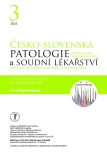Next generation sequencing and its application in the diagnostics of neuromuscular diseases
Authors:
Jana Zídková 1; Jana Haberlová 2; Tereza Kramářová 1; Lenka Fajkusová 1
Authors‘ workplace:
Centrum molekulární biologie a genetiky, Fakultní nemocnice Brno
1; Klinika dětské neurologie, Fakultní nemocnice Motol, Praha
2
Published in:
Čes.-slov. Patol., 57, 2021, No. 3, p. 150-153
Category:
Reviews Article
Overview
Neuromuscular diseases (NMDs) are a clinically and genetically heterogeneous group of diseases. Currently, 608 genes associated with different types of NMD have been identified. Most of these diseases are rare with a very low prevalence. Advance in the identification of genes associated with NMD can be attributed to technological development in an area of next generation sequencing (NGS) and the affordability of this methodical approach. NGS applications can be divided into analysis of (a) a selected set of genes, (b) an exom, and (c) a genome. The identification of pathogenic variants leads to a significant shift in the understanding of the etiopathogenesis of the disease, allows the prediction of the course of the disease, or its targeted treatment, which may be specific for individual types of NMD or even for particular pathogenic sequence variants.
Keywords:
neuromuscular diseases – NGS – diagnostics
Sources
1. Adams DR, Eng CM. Next-Generation Sequencing to Diagnose Suspected Genetic Disorders. N Engl J Med 2018; 379(14): 1353 - 1362.
2. Thompson R, Spendiff S, Roos A, et al. Advances in the diagnosis of inherited neuromuscular diseases and implications for therapy development. Lancet Neurol 2020; 19(6): 522-532.
3. Richards S, Aziz N, Bale S, et al. Standards and Guidelines for the Interpretation of Sequence Variants: A Joint Consensus Recommendation of the American College of Medical Genetics and Genomics and the Association for Molecular Pathology. Genet Med 2015; 17(5): 405–424.
4. Yuen M, Ottenheijm CAC. Nebulin: big protein with big responsibilities. J Muscle Res Cell Motil 2020; 41(1): 103-124.
5. Linke WA, Hamdani N. Gigantic business: titin properties and function through thick and thin. Circ Res 2014; 114(6): 1052-1068.
6. Stehlíková K, Skálová D, Zídková J, et al. Muscular dystrophies and myopathies: the spectrum of mutated genes in the Czech Republic. Clin Genet 2017; 91(3): 463-469.
7. Vissing J, Johnson K, Töpf A, et al. POPDC3 Gene Variants Associate with a New Form of Limb Girdle Muscular Dystrophy. Ann Neurol 2019; 86(6): 832-843.
8. Gonorazky HD, Naumenko S, Ramani AK, et al. Expanding the Boundaries of RNA Sequencing as a Diagnostic Tool for Rare Mendelian Disease. Am J Hum Genet 2019; 104(3): 466-483.
9. Mercuri E, Muntoni F, Osorio AN, et al. Safety and effectiveness of ataluren: comparison of results from the STRIDE Registry and CINRG DMD Natural History Study. J Comp Eff Res 2020; 9(5): 341-360.
Labels
Anatomical pathology Forensic medical examiner ToxicologyArticle was published in
Czecho-Slovak Pathology

2021 Issue 3
Most read in this issue
- Doporučení pro testování PD-L1: metodika testování a reportování výsledků Verze_1 (17. 5. 2021)
- Next generation sequencing – a science tool or routine pathology?
- Molecular testing in endometrial carcinoma (Joint recommendation of Czech Oncological Society, Oncogynecological Section of the Czech Gynecological and Obstetrical Society, Society of Radiation Oncology, Biology and Physics, and the Society of Czech Pathologists)
- Methylation pattern in the diagnosis and prognosis of brain cancer
